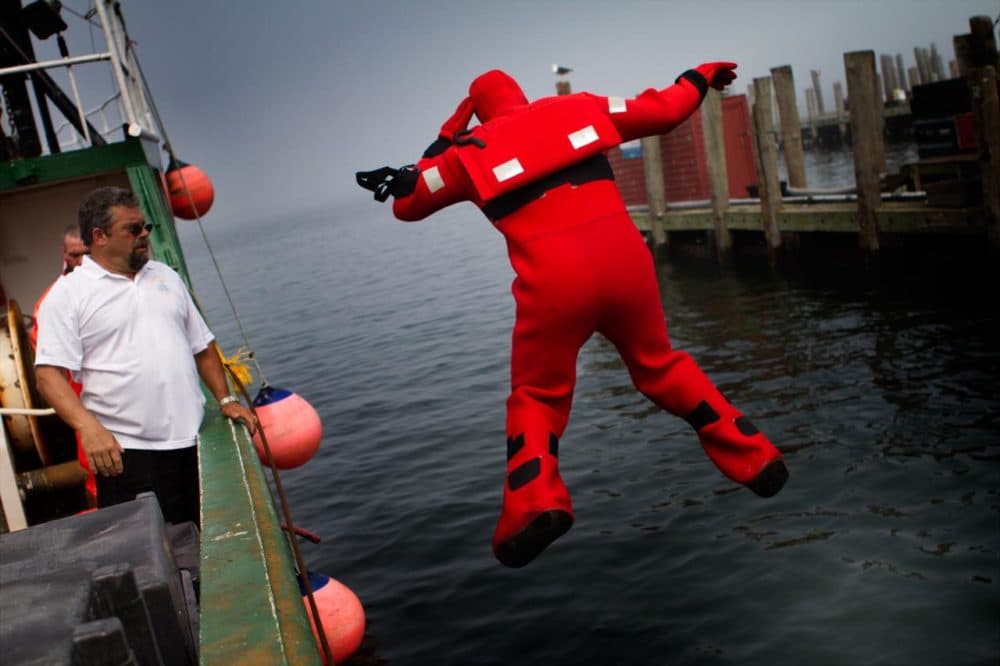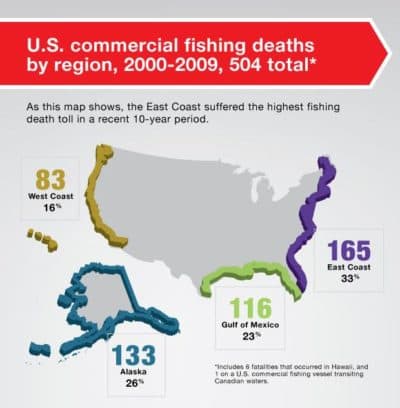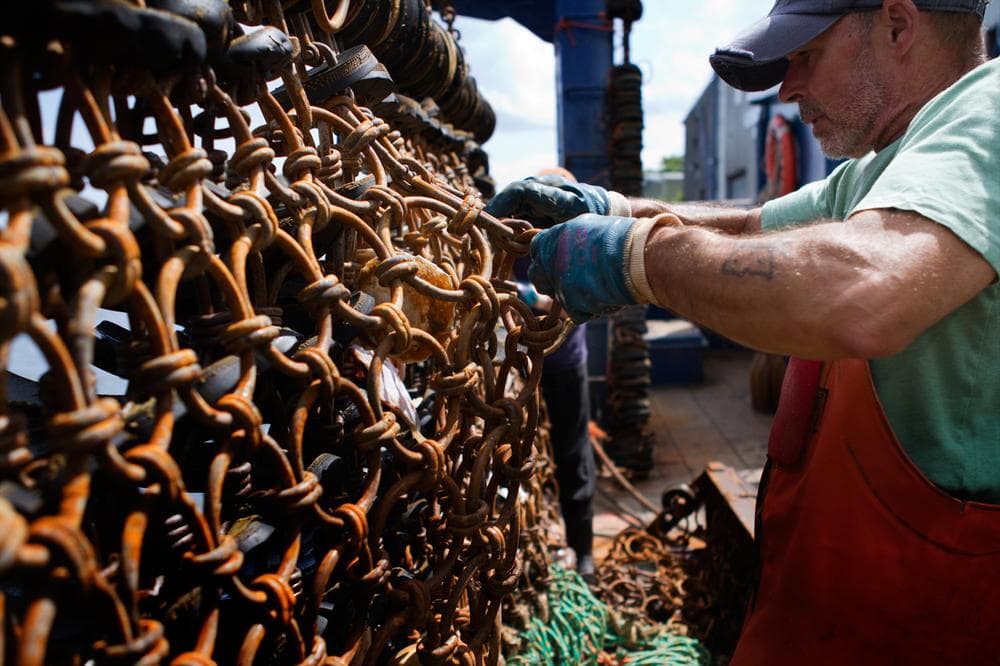Advertisement
New England Fish Are Real 'Deadliest Catch' In America
Resume
On the fishing-boat piers of New England, nearly everyone knows a fisherman lost at sea.
New Bedford, Mass., boat captain Joe Neves remembers when a crew member got knocked overboard. “We heard him screaming ‘Help me!’ ” Neves says grimacing. “But you know, on the water at night, your head is like a little coconut.” They never found him.
Mike Gallagher, of Narragansett, R.I., discovered a friend of his entangled in still-running hydraulics. “I knew right away he was dead,” Gallagher says.
And Fred Mattera was fishing 125 miles off the coast of Cape Cod when a 21-year-old — the son of a close friend — succumbed to poisonous fumes in a nearby boat. “That was a brutal week in this port,” Mattera says.
The Deadliest Catch
The Bureau of Labor Statistics ranks commercial fishing as the deadliest job in the United States. And despite the popular notion from reality TV’s "Deadliest Catch" featuring Alaskan crab fishermen, the most dangerous fishery is in the northeast U.S. From 2000-2009, workers in the Northeast multi-species groundfish fishery (including fish such as cod and haddock) were 37 times more likely to die on the job as a police officer.

A National Institute for Occupational Safety and Health report shows 70 percent of those deaths and those in the second-deadliest fishery, Atlantic scallops, followed vessel disasters such as fire, capsizing or sinking. Most of the rest were caused by onboard injuries or falling overboard, often by getting tangled in heavy overhead equipment.
Not one of those who fell overboard and drowned was wearing a life jacket.
An investigation by the Center for Public Integrity, NPR News and WBUR found that despite earning the odious ranking as America’s deadliest job, commercial fishing in the Northeast operates in a cultural tradition and regulatory environment that thwarts promising safety measures.
Out To Sea, Out Of Mind
Despite the strikingly high fatality rate in the commercial fishing industry, pushes for reforms have taken decades to come to fruition. In 1988, Congress required fishing boats to carry life boats, personal flotation devices and other safety equipment.
While the Coast Guard mandates seaworthiness inspections of passenger ferries and other commercial vessels, fishing boats are not inspected.
“We’ve... requested authority do inspections on vessels,” says Jack Kemerer, chief of the fishing vessels division of the Coast Guard. Congress again did not include that power in the U.S. Coast Guard Authorization Act of 2010.
“So I can’t answer why or why not. But it’s not that we haven’t asked for it in the past,” Kemerer says.
The Last Of The Ocean Cowboys
Even so, most fishermen don’t want to be supervised. Some are fatalistic about their life on the seas. New England fishermen used to buy steel-toed boots, believing if they fell into the frigid Atlantic, it was better to drown faster. Others espouse a rugged individualism and see themselves as the last cowboys on the ocean.
At Chatham Harbor on Cape Cod, Bill Amaru runs one of the last cod fishing boats from a harbor that used to be so profilic, fish markets labeled cod Chathams. Now strict federal rules limit how much he can catch. Many other cod fishermen have gone out of business. Amaru doesn’t like the idea of the feds inspecting his boat.
“If there’s a resentment to these kinds of rules,” Amaru says as he moors his boat in the harbor. "It’s based on the overall huge number of regulations that have come down on our industry in the last decade.”
“So much federal 'nanny state' kind of telling us how to operate, when I think I have a pretty good understanding of what I need to do to keep safe,” Amaru says.
Still, the 2010 law requires boat owners like Amaru to prove that their safety equipment is up to date. Coast Guard checks have forced many fishermen to throw out old and disintegrating life rafts and replace the expired batteries from their emergency signal beacons.
But just because they have updated safety gear doesn’t mean the crews know how to use it.

'We Will Make This A Safer Industry'
When Fred Mattera raced his boat to help fishermen overcome by poisonous fumes in a nearby boat in 2001, he didn’t know exactly what to do to help them. No one on the radio knew either.
“What I heard there was this hodgepodge [of] try this, try that,” Mattera remembers. “And nobody knew for certain.” When 21-year-old Steven Follett, the son of a close friend, died, Mattera was frustrated. Some people in port called him a hero for trying.
“Being a hero is someone survives,” Mattera says, shaking his head.
Mattera told his friend he would make good come from the loss of life. “I just said I promise you we need to change the culture. We will make this a safer industry.”
The incident turned Mattera into a safety evangelist. Earlier this month, he helped the crews of two boats organize disaster and man overboard training.
Getting The Panic Out
In one exercise, crew members have clumsily put on bright orange-red survival suits. Insulated, watertight and buoyant, the immersion suit covers each fisherman from head to toe; only their faces are exposed. They step off the boat into the calm dockside water. But even in these conditions, wearing a “Gumby suit” feels claustrophic to some and they thrash around until they get their bearings.
“Get your panic out now!” Fred Mattera shouts from the deck. These guys are practicing abandoning ship in the case of a fire or capsizing. The immersion suits are designed to keep them alive and afloat in the icy Atlantic until someone can rescue them.
Mattera coaches them to link up with each other back-to-back and to paddle together over to a life raft to climb in.
When it’s all over, they look winded.
“There’s a ‘holy crap!’ issue to it,” boat captain Norbert Stamps says of the fair-weather training. “You jump in. You kind of realize that this isn’t fun and games, this is real serious stuff! And you gotta practice and you gotta know what to expect.”
Crew member Mike Gallagher says such fishermen-organized trainings are becoming more common.
“To be honest with you,” Gallagher says, “the safety thing hasn’t really been paid much attention to until the past several years. Really, it’s been overlooked.”
Learning From Alaska
Alaskan waters had been viewed as the most hazardous place for commercial fishing. That is, until a closer focus on safety reduced the number of fatalities in those fisheries.
“I believe fishermen want to be safe,” says National Institute for Occupational Safety and Health epidemiologist Jennifer Lincoln, who’s based in Alaska. “They just want things to be practical. They want the solutions to really address the hazards that exist.”
In Alaska, fishermen, state regulators and the Coast Guard have worked together to make fishing less deadly:
- Bering Sea crabbing boats now transport fewer crab pots when they head to out to sea. That weight limit prevents capsizing. Fatalities fell by 60 percent.
- Since capsizing often occurred in deaths of Alaska salmon fishermen, skiff operators are now allowed the option of leaving immersion suits off their small boats as long as they wear a life preserver at all times.
- Pilot projects with life preservers designed for their working conditions encouraged scallop boats to require crew members to wear them.
That kind of safety progress is what Fred Mattera and others want to replicate in the Northeast, the home of today’s deadliest catch. Since the death of his friend's son in a fishing accident in 2001, Mattera has trained hundreds of fishermen at Point Judith, R.I.* But he’s not done.
Fred Mattera hopes that someday, the deadliest job in America will only be as dangerous as it has to be, and not one bit more.
Our stories about dangers in the commercial fishing industry were jointly reported by the Center for Public Integrity, WBUR and NPR News. The stories are part of CPI's Hard Labor series on workplace safety.
Correction: An earlier version of this article contained an inaccurate location for the safety training. The safety training was located at Point Judith, R.I., in August 2012.
This program aired on August 22, 2012.

